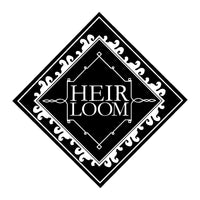

What drew you to the world of textiles? How/when did you first get involved in weaving and quilting?
I grew up surrounded by textiles. My mom would sew our curtains, bed pillows, and cushions using fabric from our local Walmart, and my aunt was a skilled tailor. Textiles were always used around me. In school, I explored fashion design and a surface design class opened my world. Quilting felt accessible and I loved the creative process of piecing fabrics together. Weaving, on the other hand, seemed intimidating at first. But after taking a couple of classes, I discovered that I really enjoyed the mathematical precision and rhythm of working with the loom.
What part of textile history interests you the most? Are there any textile artists that you are influenced by?
I’m most influenced by textiles that tell stories through pictorial images like quilts. Because I source the majority of my fabric from thrift shops and places like Goodwill, African American Quilts of the South help me understand the possibilities of what can be created with scraps and found fabrics. Faith Ringold played a major part in my exploration of what a quilt could be— from storytelling to the different mediums she applied.

Where/what do you look to for inspiration? Has this changed over time or stayed constant?
I often find inspiration in textiles that already exist. Whether it’s a color or a print that I can relate to. From there, a story tends to develop related to my childhood, American politics, or nature. So far it’s been consistent and just becomes more and more abstracted.
Tell us about your process, start to finish how you conceive of and make your pieces.
I’m a collector at heart, always on the lookout for textiles or objects that catch my eye. Recently, I’ve been particularly drawn to intense solid colors, which often become the starting point for my creative process. From there, I create other cloth or motifs that center around themes of home, America or nature and sometimes combine all three. Portals have become a central motif in my work lately, along with creating imitations of the fabrics or objects I discover. These elements allow me to reimagine their stories and give them a new context within my pieces.

You’re originally from South Carolina. How long have you been making art in New York? Has this environment changed your work or process? You also recently traveled to Ghana, how do ‘home,’ travel, and place show up in your work?
I’ve been making art here since I moved 7 years ago. If anything, I find myself becoming more nostalgic and thinking of the southern landscape of South Carolina more and more. When I travel back home, certain environmental motifs and remnants of the past become more apparent after being in the city for so long. Differently, when traveling to Ghana, I am amused by the use of the natural materials in basket weaving and wood carving. This has influenced me to use more raw materials and look into the natural world of the American South.
You chose the name, “Weaving Portals” for this showcase. Can you tell us a little more about what inspired that choice?
Once gathering my most recent work, I noticed that the majority of the pieces feature a central focus point and transportative motifs like spirals and mirrors. I figured “Weaving Portals” captured the idea of going somewhere otherworldly where I hope the viewer would go looking into my work.
You have described yourself as an “explorative artist,” what does that mean for you?
I find myself always wanting to learn more and express myself through different mediums. I feel like “explorative” captures my love for collecting memorabilia, continuing to take classes, and the happy accidents that happen in my work.

How do you imagine your work evolving in the future?
I hope my work continues to evolve. I hope to keep learning new applications and skills that take my work to the next level. I’ve also been so intrigued by furniture and homeware that I would love to make things that could live in one’s home that are more than decorative.


